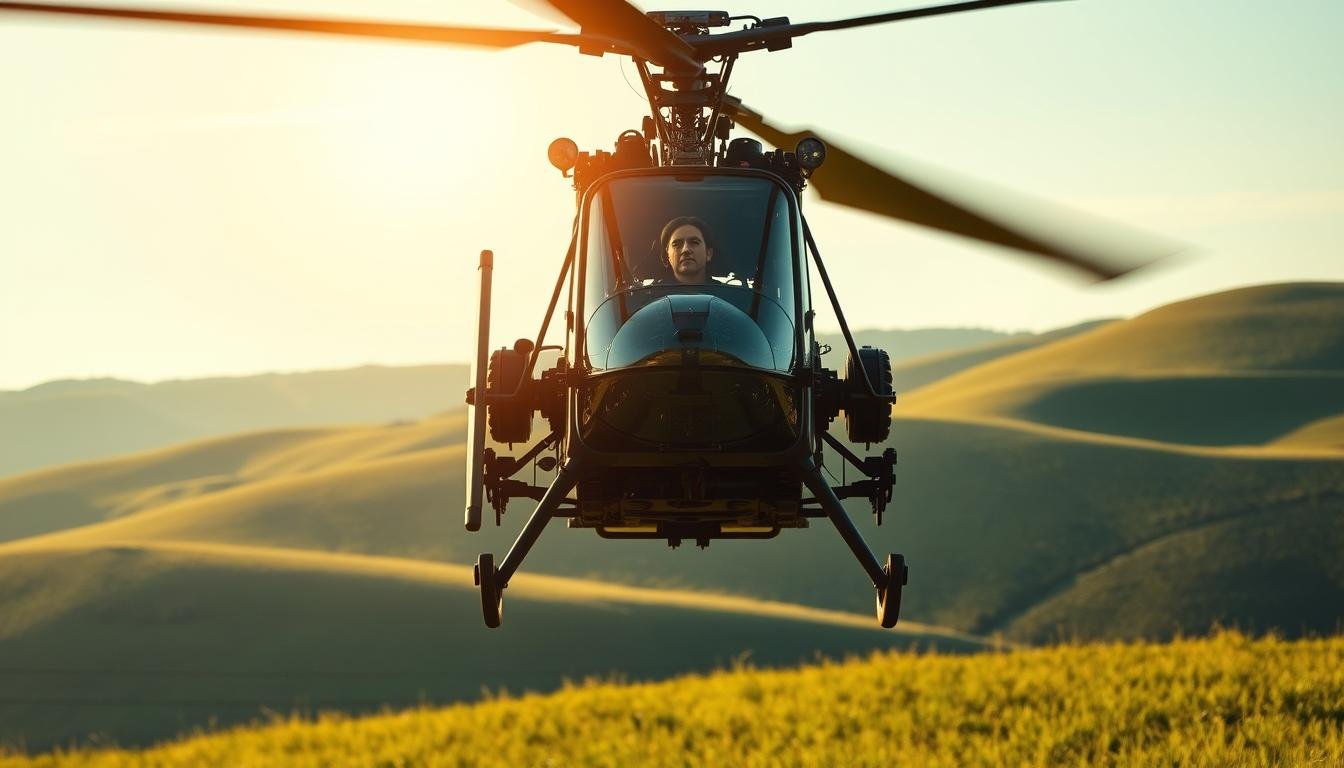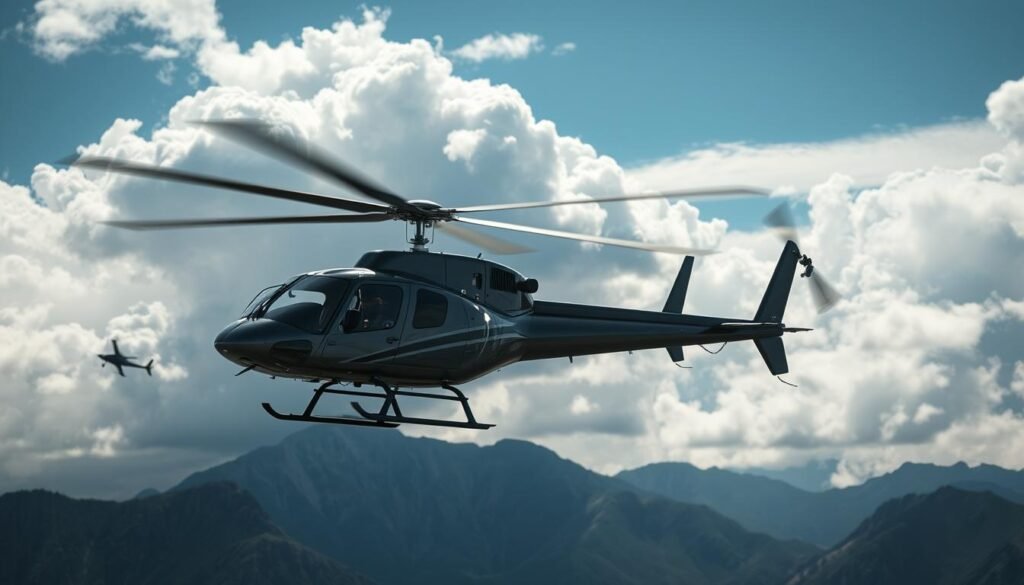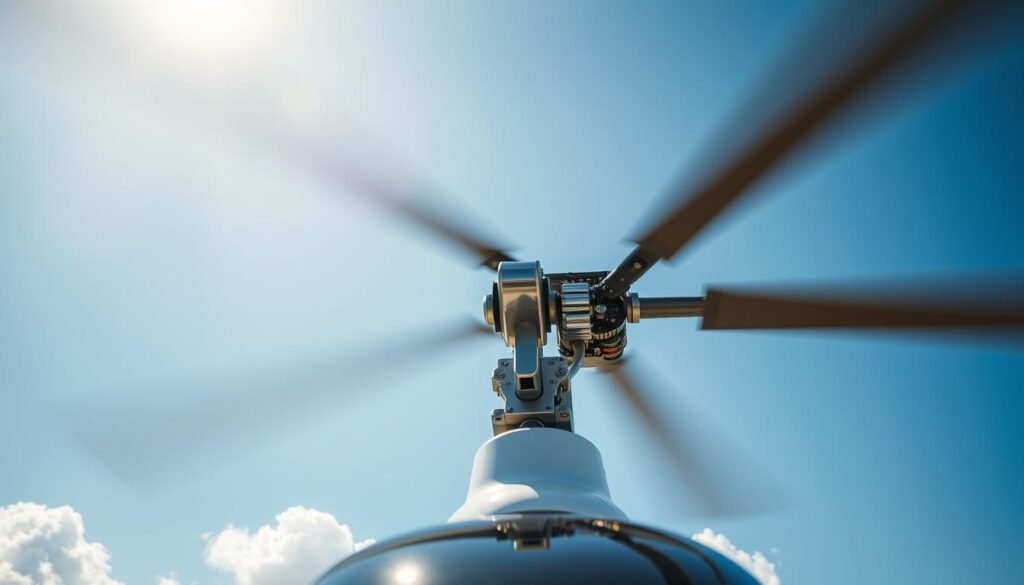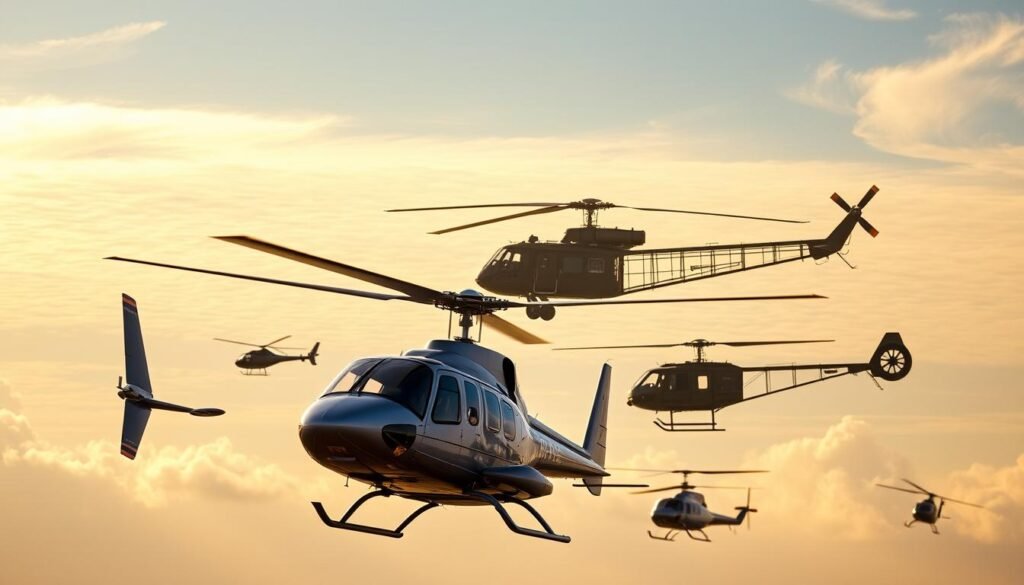The first helicopter in the world began a shift that let aircraft hover, rise vertically, and reach places fixed-wing planes could not.
Early work proved vertical takeoff, landing, and stable hovering were possible. The Focke-Wulf Fw 61 showed practical, controllable rotorcraft flight in 1936. Igor Sikorsky refined rotor placement with his VS-300 in 1939 and then the Sikorsky R-4 reached production by 1942.
Design and control systems evolved fast. Engineers solved anti-torque, swashplate control, and power issues that let pilots manage lift and direction. These advances opened lifesaving missions, shipboard use, and rescue ops in remote areas.

Readers curious about key milestones can follow a concise timeline and technical view, including rotor mechanics and engine progress. A clear, illustrated link traces these facts and adds context: top rotorcraft milestones.
Key Takeaways
- The Focke-Wulf Fw 61 proved controllable vertical flight in 1936.
- Igor Sikorsky’s VS-300 refined single-main-rotor with tail-rotor layout.
- The Sikorsky R-4 entered full production by 1942, scaling use.
- Rotors gave true hover and multidirectional flight, enabling new missions.
- Design advances in control and engines made modern rotorcraft reliable.
The First Helicopter In The World: Context, Definitions, And Why It Matters
Clear criteria help separate early experiments from truly controllable vertical aircraft. This section defines how historians assign milestone status. It shows why documented tests, repeatability, and usable design matter for aviation history.
What “First,” “Successful,” And “Practical” Mean In Vertical Flight
World first marks a recorded, repeatable achievement that changed design practice. A first successful machine must show sustained hover, directional control, and an anti-torque solution.
First practical adds reliability and usable pilot workload. It means safe takeoff, hover, and landing under real conditions, not fleeting hops.
From Concept To Controllable Flight: Setting The Criteria
Criteria include a documented test program, measurable performance, and a control system that allows predictable inputs and responses. Rotor dynamics, anti-torque, and swashplate interaction are central.
- The Focke-Wulf Fw 61 met these benchmarks and serves as a benchmark for a true first successful machine.
- Igor Sikorsky’s VS-300 evolved from testbed to a dominant configuration; see the VS-300 milestone for details: VS-300 milestone.
- Establishing clear definitions avoids mixed claims and helps compare designs fairly.
Early Attempts At Vertical Flight Before A World First
Trials with toy rotors, weighty steam frames, and weak engines exposed power limits that stalled many designs.

From Toys And Steam To Pioneering Prototypes
Inventors began with simple models that showed how air moved around blades. These toys used rubber bands to spin rotors and taught basics of lift.
Steam rigs and tiny internal combustion engine testbeds followed. Engineers sought an engine that gave enough thrust for a machine to rise beyond a few feet.
Igor Sikorsky built an early rotor craft in 1909 with a 25 hp Anzani engine. It could not lift off. His 1910 model lifted its own weight but not a man.
Autogyros helped progress. Their free-spinning rotor and separate thrust clarified rotor aerodynamics, yet they differed from powered-rotor designs that enable true hover and horizontal control.
- Early work revealed induced flow, tip vortices, and drag problems around blades.
- Prototypes often managed only brief hops a few feet above ground.
- Lessons led to better blade shape, stiffer hubs, and improved anti-torque ideas.
| Period | Power Source | Typical Outcome |
|---|---|---|
| Late 1800s–1900s | Rubber, Steam | Short tests; proved lift concept |
| 1909–1910 | Small Internal Combustion (25 hp) | Structure lifted; pilot lift failed |
| 1920s–1930s | Improved Engines | Longer hops; better rotor understanding |
By mid-1930s, cumulative findings about engines, rotor behaviour, and control systems set stage for a controllable, practical rotorcraft breakthrough.
Focke-Wulf Fw 61: The First Successful, Practical, Fully Controllable Helicopter
The Focke-Wulf Fw 61 demonstrated a clear world first for rotorcraft in 1936. It proved controlled hover, smooth transitions, and sustained flight that a pilot could manage reliably.
Design gave the pilot direct authority over yaw, pitch, and roll through coordinated blade pitch and proven power transmission. This moved rotorcraft beyond brief hops to flights measured in minutes and reached heights of hundreds of feet.
Engine reliability, careful rotor geometry, and attention to vibration and blade articulation generated usable data. Engineers used those findings to refine anti-torque solutions and flight controls across Europe and later the United States.

- Controllability: Pilot could fly with precision.
- Endurance: Tests lasted minutes, not seconds.
- Performance: Demonstrations reached hundreds of feet.
For technical background and archived details, see Fw 61 details.
Igor Sikorsky’s VS-300: The Prototype That Shaped Modern Helicopters
Sikorsky’s VS-300 turned iterative tests into a clear configuration that shaped rotorcraft for decades. This prototype established a layout focused on a single main rotor paired with a tail rotor to counteract torque. Pilots and engineers found the setup easier to fly and maintain than complex multi-rotor arrangements.

Single Main Rotor With Tail Rotor: A Defining Configuration
The single main rotor concentrated lift and simplified power transmission.
Tail rotor thrust provided reliable yaw control and made stable hover possible. This design cut mechanical complexity while keeping effective control authority.
From Tethered Tests To Free Flight: 1939-1940 Milestones
VS-300 achieved a tethered flight on September 14, 1939, then a free flight on May 24, 1940.
Those events proved the prototype could move from bench trials to practical flight within a year of focused work.
Design Lessons That Informed Production Models
Testing highlighted rotor hub articulation, swashplate mechanics, and tail rotor thrust as priorities.
Improvements to drive systems, rotor heads, and control linkages fed directly into the R-4, validating a path from prototype to production.
- Control harmony: cyclic, collective, pedals balanced pilot inputs.
- Reliability: drive and rotor improvements extended flight duration.
- Configuration: simpler layout became industry standard.
| Aspect | VS-300 Result | Impact On Later Models |
|---|---|---|
| Rotor Layout | Single main rotor + tail rotor | Standardized aircraft configuration |
| Key Dates | Sep 14, 1939 (tethered); May 24, 1940 (free) | Validated concept quickly |
| Control Systems | Swashplate, cyclic, collective, pedals | Improved pilot control and training |
For technical reference and archival context see VS-300 details.
Sikorsky R-4: The First Helicopter To Reach Full-Scale Production
C rapid shift from XR-4 trials to R-4 production proved vertical lift could meet wartime demands for rescue and logistics.
By 1942, Igor Sikorsky moved a proven prototype into mass manufacture. The XR-4 arrived that year and soon became a production model used by US forces. This change marked when rotary aircraft left experimental test fields and joined operational fleets.

XR-4 To R-4: Model Evolution And Timelines
The XR-4 demonstrated stability and control that engineers refined quickly. Lessons on the rotor head, controls, and drive system sped adoption. Production in 1942 meant parts, training, and procedures scaled to support multiple units.
Early Missions: Cross-Country Flights, Ship Landings, And Rescues
Operational use proved value fast. An XR-4 completed a cross-country flight, then a 1943 ship landing on USS Bunker Hill showed deck operations were feasible.
On January 3, 1944, Commander Frank Erickson flew a mercy mission delivering plasma. Later that year Lt. Carter Harman executed a combat rescue. These events validated flight range and search-and-rescue tactics.
- Production shifted rotorcraft into service roles.
- Training and maintenance supported broader aircraft deployment.
- As the only helicopter to serve in World War II, the R-4 set standards for landing, rescue, and naval ops.
For technical reference, see Sikorsky R-4.
Single Main Rotor And Tail Rotor: Anatomy Of Control And Stability
Most modern rotorcraft use a single main rotor paired with a smaller rear rotor to manage torque and steer yaw. This simple layout concentrates engine power for lift while assigning anti-spin duties to a compact tail unit.

Main Rotor Lift, Tail Rotor Anti-Torque, And Yaw Control
The main rotor generates primary lift and thrust. Pilots use cyclic and collective inputs to tilt the rotor disk and change blade pitch. That manages attitude and climb rate.
A tail rotor provides anti-torque thrust so the fuselage does not spin. Pedals modulate tail thrust to hold heading or create yaw. Typical RPM ranges help keep both rotor and tail within safe envelopes: main rotor often spins 300–600 RPM while tail units run faster, commonly 1,000–5,000 RPM.
Alternative Anti-Torque Systems: Fenestron And NOTAR
Fenestron ducted fans and NOTAR using the Coandă effect remove a conventional tail rotor. Each offers quieter operation and reduced risk of rotor strikes. Counter-rotating configurations—coaxial, tandem, transverse, and intermeshing—balance torque with two or more rotors so no tail thrust is needed.
- Main rotor creates lift and thrust; tail rotor keeps yaw stable.
- Blade articulation and a swashplate enable precise control of rotor thrust vectors.
- Different configurations change power distribution, efficiency, and maintenance needs.
Engines That Made Vertical Flight Possible
Progress came when compact powerplants matched rotor needs for sustained hover and forward flight.
From Piston To Turboshaft: Power, Weight, And Reliability
Early attempts used rubber motors and steam, then small piston units that often lacked power-to-weight for useful lift. Flat and radial layouts improved cooling and mass balance and let craft carry pilots and gear.
Turboshaft units changed performance. The Kaman K-225 used a turbine in December 1951, showing higher power with lower mass and far better reliability. That shift let larger aircraft fly faster, carry more, and work longer hours.
Transmissions lower high engine RPM (3,000–50,000) to main rotor RPM (300–600) so blades make efficient lift. Tip-jet engines removed torque but cost fuel and made noise. Small UAVs now use electric motors for quiet, simple operation.
- Engine evolution unlocked practical rotorcraft missions.
- Power management links directly to rotor control during hover, climb, and cruise.
- Choice of powerplant affects speed, payload, and operating cost.
Helicopter Flight Controls: Cyclic, Collective, Pedals, And Throttle
Pilots use coordinated inputs to manage lift, rpm, and heading while air moves around rotating blades. A clear control layout lets a crew keep stable hover and move into forward flight with confidence.
Hover, Translational Lift, And Managing RPM
Cyclic tilts the rotor disk to command forward, aft, or lateral motion. Collective changes blade pitch to raise or lower lift for climbs and descents.
Anti-torque pedals adjust tail thrust for yaw and to counter main rotor torque. Throttle keeps engine power high enough so rotor rpm stays within safe limits across seconds, minutes, or an hour of operation.
Translational lift begins near 16–24 knots as the machine gains clean air and needs less power to climb or cruise.
Swashplate Mechanics And Control System Integration
The swashplate converts pilot commands into cyclic and collective blade pitch changes. A linked control system reduces pilot workload by balancing friction and trim so inputs hold steady while other tasks occur.
For a technical primer on cockpit inputs and mechanical links, see helicopter flight controls.
World War II Deployments: The R-4 In Service
During World War II, the Sikorsky R-4 moved from prototype trials to active duty and proved vertical rescue and logistics could work under combat stress.
The small rotorcraft served as the only helicopter used during that global conflict. Crews logged ship deck work, medevac runs, and combat extractions that reshaped doctrine.
Medical Evacuations, Shipboard Operations, And Combat Rescue
Onboard landing happened on USS Bunker Hill in 1943, showing deck operations were feasible for aircraft carriers and escort vessels.
On January 3, 1944, Commander Frank Erickson flew a mercy mission delivering blood plasma through snow squalls. That effort proved rapid vertical access could save lives when other planes stood down.
Later in 1944, Lt. Carter Harman executed a combat rescue that validated extraction from terrain unreachable by conventional means.
| Mission Type | Date | Outcome |
|---|---|---|
| Shipboard Landing | 1943 | Deck procedures and safe landing practice established |
| Mercy Mission (plasma) | Jan 3, 1944 | Life saved during snow squalls; rapid medevac proven |
| Combat Rescue | 1944 | Personnel recovered from hostile terrain |
Pilots learned to manage rotor limits during tight takeoffs and landings on small decks. Many missions flew at low altitudes measured in feet. Quick actions—sometimes down to seconds—made critical differences.
Operational lessons guided training, spares, and maintenance. Postwar planners used that data to fund larger, more capable models and cemented the helicopter as an essential rescue and support tool.
Postwar Innovations: Records, Speed, Altitude, And New Designs
A series of postwar breakthroughs pushed rotorcraft into new missions and set benchmark performance marks. Rapid adoption of turbine power, improved rotors, and novel gearboxes let designers chase speed and altitude goals while adding heavy-lift and maritime roles.
From S-51 To S-64: Expanding Roles And Capabilities
After 1945, Sikorsky models broadened roles from rescue and mail to anti-submarine warfare, heavy lift, and airline service. The S-51 led civilian rescue and naval medevac duties and helped prove everyday utility.
The S-56 introduced a five-blade main rotor and later became a twin-engine production model, raising payload and redundancy. The S-64 opened a heavy-lift niche for construction and firefighting.
Speed And Altitude Records That Defined An Industry
S-52 stunned observers with a 129.5 mph speed record and a daring loop during 1949, showing aggressive maneuvering was possible. Turbine tests followed fast.
The turbine S-59 set new marks: a 156.005 mph top speed and 24,500 ft altitude in 1954. Later S-61 variants kept pushing speed records and proved commercial aircraft variants could serve airlines.
- Performance: Record flights validated reliability and paved paths for more complex missions.
- Specialization: S-55 crossed an ocean and added anti-submarine roles, while cranes and transports enlarged practical use.
- Legacy: Igor Sikorsky’s leadership guided many of these models into service and shaped industry progress.
Beyond The Monorotor: Tandem, Coaxial, Tiltrotor, And Multirotor Paths
Different rotor layouts answer unique mission demands, from heavy lift to urban ops.
Twin-rotor designs, such as tandem or transverse setups, excel where payload and center-of-gravity control matter. They remove a conventional tail and let crews haul bulky loads with more stability.
Payload, Efficiency, And Mission-Driven Configurations
Coaxial rotors stack counter-rotating blades to cancel torque and shrink footprint for ship decks and confined pads.
Tiltrotor craft blend vertical lift with wing-borne cruise. That tradeoff gains airplane-like speed and longer range by shifting flight to fixed wings for cruise.
Compound Concepts And The Quest For Higher Speed
Compound designs add wings and separate thrust systems to offload rotor lift during cruise. This design push seeks higher top speed while keeping hover ability for confined operations.
- Multirotor layouts, notably quadcopters, dominate UAV roles where agility and low cost matter.
- Each option forces trade-offs among payload, hover efficiency, forward speed, and upkeep.
- Rotor layout shapes tail needs, airframe loads, and control laws, affecting pilot training.
For a technical primer on controls and systems across layouts, see helicopter.
Legacy In The United States: Industry, Safety, And Everyday Uses
Sikorsky Aircraft in Stratford, Connecticut, anchors a national manufacturing hub that shaped modern rotorcraft use. This industry created standards for certification, training, and safety that spread across the U.S.
Emergency medical services, law enforcement, offshore rigs, firefighting, utility work, and news teams rely on rotorcraft daily. Careful procedures, robust maintenance, and skilled pilots let missions run safely and often under severe conditions.
Key Practical Benefits:
- Rapid access to crowded cities and remote terrain where fixed-wing aircraft cannot land.
- Precision hovering and tight-spot landings that speed rescues and repairs.
- Industry ecosystems that supply parts, training, and regulation for consistent performance.
| Role | Typical Use | Impact |
|---|---|---|
| EMS | Rapid patient transport | Lives saved via quick access |
| Offshore Energy | Crew transfer and inspection | Operational continuity for platforms |
| Firefighting | Water drops, reconnaissance | Containment and protection of communities |
| News & Utility | Aerial reporting and construction lift | Public information and infrastructure support |
Local landmarks—such as Sikorsky Memorial Bridge and Sikorsky Memorial Airport—mark how innovation left a visible legacy. U.S. fleets and airports show a history of steady technical progress that continues to shape aircraft policy and community services around the world.
Final Thoughts
This brief history shows how rapid milestones shaped rotorcraft progress. The Fw 61 in 1936 proved a first successful, first practical controllable craft that changed expectations about vertical lift. Igor Sikorsky’s VS-300 then set a durable design: single main rotor plus tail. By 1942 the R-4 moved that design into production and service.
These advances made helicopters reliable aircraft for rescue, transport, and military work. Readers who want more inventor context can visit who invented this craft. For safety and mission evolution details, see a practical review at rotorcraft safety explained.
Understanding those early years clarifies why certain design choices persist and how modern fleets built on that compact span of time.
FAQ
What counts as the world’s first successful practical vertical-flight aircraft?
It means a rotorcraft that performed controlled, sustained, and repeatable flight with useful payload capability and practical control systems. Engineers judge success by free flight without tethers, reliable lift from rotors, stable yaw control, and the ability to land safely. Designs that only hovered for seconds, or lacked control authority, do not meet these practical criteria.
Which machine demonstrated fully controllable rotor-based flight before mass production?
A German prototype from the 1930s proved that a single main rotor with a tail rotor could deliver steady, controllable flight. Pilots flew it freely, demonstrating sustained altitude, lateral control, and directional stability, which informed later production models worldwide.
How did Igor Sikorsky’s VS-300 influence future aircraft designs?
The VS-300 introduced the single main rotor paired with a tail rotor as a reliable layout. Sikorsky refined cyclic and collective controls and the swashplate system during tethered and free flights, creating a configuration that aircraft manufacturers later adopted for production helicopters.
What role did the Sikorsky R-4 play during World War II?
The R-4 became the first rotorcraft produced at scale for military use. It performed medical evacuations, shipboard landings, and rescue missions. These operational deployments validated rotorcraft utility under combat and maritime conditions.
How do main rotor and tail rotor systems work together to control lift and yaw?
The main rotor produces vertical lift and provides cyclic input for pitch and roll. The tail rotor counters torque from the main rotor, allowing the pilot to control yaw with pedals. Together these elements permit hover, transition to forward flight, and precise maneuvering.
What alternative anti-torque solutions exist besides a tail rotor?
Engineers developed systems like the fenestron, which encloses a fan in the empennage, and NOTAR, which uses directed airflow along the tail boom. Both reduce noise and vulnerability while maintaining anti-torque control for yaw management.
Which engine types enabled sustained vertical flight through the decades?
Early rotorcraft used piston engines with limited power-to-weight ratios. The advent of turboshaft engines delivered higher power with lower weight, greatly improving payload, range, and reliability. Turboshafts remain standard for most modern rotorcraft.
What are the primary flight controls a pilot uses in a rotorcraft?
Pilots manipulate the cyclic for pitch and roll, the collective to change total lift, and foot pedals to manage yaw via the anti-torque system. Throttle or governor systems keep rotor RPM within safe limits during maneuvers like hover and translational lift.
How did early prototypes transition from tethered tests to free flight milestones?
Inventors began with tethered trials to verify lift and control inputs. After refining rotor geometry and control linkages, engineers conducted untethered flights that demonstrated stable hover, controlled climbs to several hundred feet, and sustained durations measured in minutes and hours.
What records and performance metrics defined postwar rotorcraft advancement?
Manufacturers pursued speed, altitude, payload, and endurance records. Designs expanded from single-seat machines to larger types like Sikorsky’s S-51 and S-64, which raised payload and operational scope. Speed and altitude achievements pushed materials, engine, and aerodynamic development.
How do tandem, coaxial, and tiltrotor configurations compare to single main rotor layouts?
Tandem and coaxial designs improve payload and compactness by distributing lift across multiple rotors, reducing or eliminating the need for a tail rotor. Tiltrotors combine rotary-wing hovering with airplane-like cruise speeds by tilting propulsion units, trading complexity for higher transit speed and range.
Why is the historical development of early rotorcraft important for today’s aviation?
Early breakthroughs established core technologies—swashplates, cyclic control, anti-torque systems, and reliable powerplants. Those innovations created an industry that serves search and rescue, medical transport, military operations, and civilian roles. Understanding origins helps guide future design and safety improvements.
Additional Resources
Sikorsky’s Contributions to Helicopter Development – Sikorsky Archives
- Learn more about Igor Sikorsky and the development of the VS-300, which revolutionized vertical flight. The Sikorsky Archives provides detailed insights into the life and work of the pioneer of modern helicopters.
- Sikorsky Archives – History and Innovation
Helicopter History and Development – Smithsonian National Air and Space Museum
- The Smithsonian’s National Air and Space Museum offers a deep dive into the history of helicopters, from early concepts to the modern designs that shape the aviation industry today.
- Smithsonian National Air and Space Museum – Helicopter History



